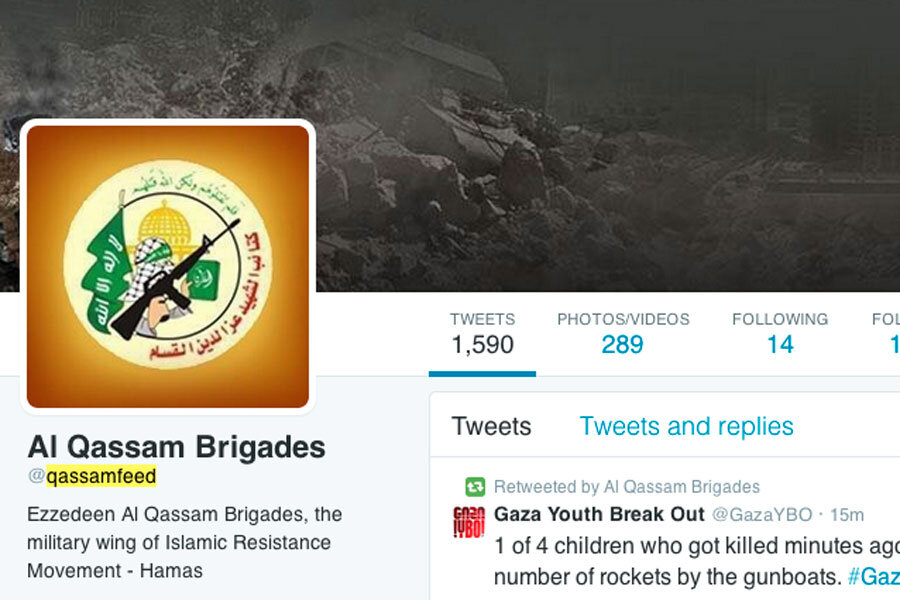In social media battle, IDF uploads while Hamas accounts are deleted
Loading...
With dueling Twitter hashtags, Facebook posts and YouTube channels, the Israeli Defense Forces and Hamas, the Palestinian militant group, are trading not just fire but also barbs over social media, in an attempt to win hearts and minds around the world. But Hamas, barred from certain platforms, faces additional challenges in the Internet war.
In this round of violence, the social media battle has become increasingly important. Israel’s ability to wage its campaign in Gaza depends on the level of international criticism it sustains. Public opinion in Europe, the United States, and the Middle East could determine whether the conflict drags on or is brought to a halt.
On Wednesday, Twitter suspended several accounts used by Hamas on Wednesday. One page, used by the organization's military-wing, Al Qassam Brigades (@qassamfeed), drew 15,000 followers. Tweets from @qassamfeed have been embedded and quoted in many Western news reports, including those filed by the BBC and The Guardian.
The link to @qassamfeed now reads, “Account suspended. The profile you are trying to read has been suspended.” (Here's a cached version of the account).
Twitter’s terms of service block use of the website to “a person barred from receiving services under the laws of the United States or other applicable jurisdiction.” Hamas is classified as a terrorist organization by the State Department, denying it access to American commercial products.
A Twitter spokesman defended the removal in an e-mail, writing that the company could not comment on specific accounts due to “privacy and security reasons,” but provided a link to its company policies, which lists the “violations that can lead to account suspension.”
The social network has previously shut down Hamas accounts, notably in 2012 during the last bout of Israel-Gaza fighting.
Facebook maintains a similar policy, and has deleted dozens of Hamas accounts due to American government restrictions.
“We don’t allow terrorist groups to be on Facebook,” says Israel Hernandez, a company representative. “There are no pages of Hamas on Facebook, he added, referring to the site's whack-a-mole approach to removing the pages.
Removed Facebook pages include the account of Hamas spokesman Izzat al Risheq, "Al Aqsa TV," and fan pages of Hamas premier Ismail Haniya.
YouTube and other social media organizations also ban the militant organization from online activity.
Despite the Hamas deactivations and network suspensions, both Israeli and Hamas press offices have continued to produce tweets, status updates, and media graphics since the beginning of the Israeli operations on July 8.
Both have enlisted the support of non-combatants in an attempt to sway perceptions, with Israeli student unions have opened ‘hasbara’ – public relations – war rooms to disseminate pro-Israel talking points. Hamas has created a Hebrew-language Twitter feed and produced music videos in Hebrew, all part of an effort to speak to the Israeli people directly. As of press time, the Hamas Hebrew-language Twitter page had not been deactivated.
Posts from the IDF and Hamas showcase the suffering inflicted on each side's civilian population alongside cartoons and checklists justifying armed activity.
"The IDF Spokesperson"’s Twitter feed depicts images of damaged Israeli homes alongside graphic displays of how Israel tries to avoid civilian casualties.
In one dramatic video uploaded Wednesday, an Israeli pilot asks his commander to cancel a bombing raid after detecting civilians near the target.
Hamas’ former Twitter feed included images of children killed in Israeli airstrikes.
On Twitter, Hamas criticized mainstream media coverage of the conflict, alleging that The New York Times was guilty of bias. It also claimed that Hamas rockets are “in response to [Israeli] attacks on civilians.”
The New York Times, meanwhile, reports that supporters on both sides have twisted the truth.
Partisans on both sides have shared images that appear to support their point of view that, on closer inspection, turned out to have been either misidentified or even fabricated. One widely-shared image posted by Israelis using the #IsraelUnderFire tag, apparently showing a devout Muslim protester holding placards that read “Stop Hamas Terrorism on Israel” and “Free Gaza From Hamas,” appears to have been created by digitally manipulating a genuine news photograph of a November 2012 protest in Sarajevo.
The two sides' conflicting hashtags, #IsraelUnderFire and #GazaUnderAttack, draw a constant stream of tweets from sympathizers and antagonists.
Who's winning this war?
By one measure: Hamas. According to Brandwatch, a company that monitors social media trends, #Gazaunderattack had been used in 622,000 tweets in a week and a half, with 36,200 tweets for #IsraelUnderFire.






